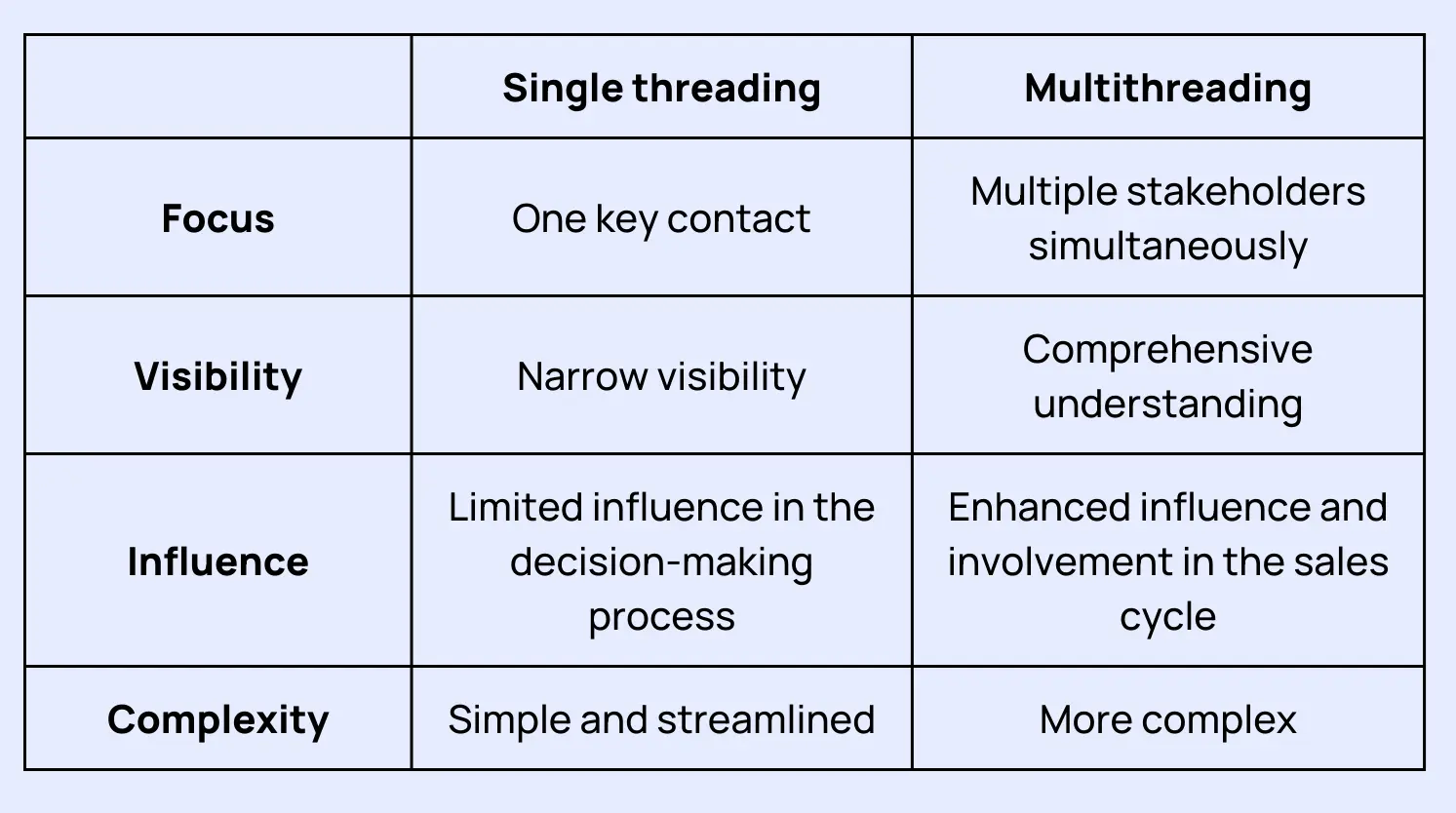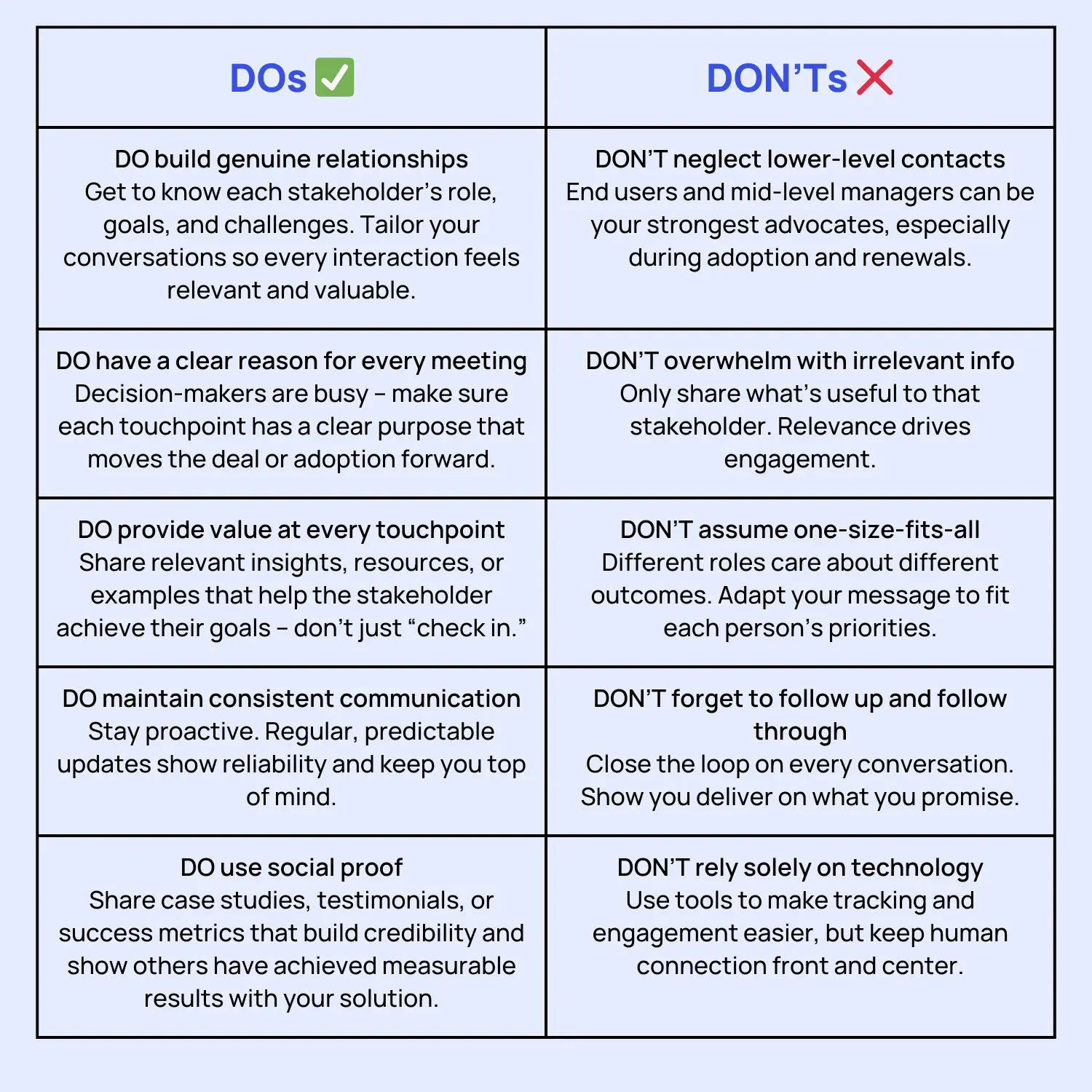How to Master Multithreading in Sales and Customer Success

You’re cruising toward the finish line. Your champion is hyped, the business case is tight, and procurement is lined up. Then – silence. A week later, you find out a new VP joined the team, had concerns you never heard, and now your deal is “under review.”
That’s the hidden cost of single-threading: When your entire sales motion hinges on one relationship, a single org change can wipe months of work off the table.
In the complex B2B landscape, you’re not selling to one person. Enterprise and mid-market deals now involve an average of 7–10 decision-makers, each with different priorities, risks, and incentives. The same is true post-sale, where renewals and expansions can stall if your internal champions move on.
The solution isn’t more calls, more notes, or more LinkedIn stalking. It’s multithreading – building and maintaining strategic relationships across the entire stakeholder map, so deals keep moving, even when players change.
Done well, multithreading doesn’t just protect your deals. It shortens sales cycles, increases win rates, and gives you leverage to expand accounts faster. And the best part? With the right process and tools, it can be automated.
In this guide, we explore the fundamentals of multithreading and its benefits and provide practical tips to implement it in your sales and customer success processes. You don’t need to be a master to start this guide, but you will become one.
What multithreading actually looks like in 2025
Multithreading in sales is the process of communicating with many stakeholders at the target organization throughout the selling process as well as post-sale. Remember the last time when you had a new person join the demo call out of the blue? Multithreading helps you discover those people who can potentially influence the buying decision and communicate with them individually.

However, it is not only about communication; it is about building a personal relationship with each one of them. At heart, multithreading allows the sales team to reach more stakeholders, thus acquiring deeper insights into the prospects’ business needs and building stronger relationships internally, leading to higher chances of success. Multithreading also helps you reduce the risks of a personnel change mid-sale or spot a shift in organizational priorities early on.
Yet, traditional multithreading was just… emailing a couple of extra people on the thread. It was manual, inconsistent, and often awkward. In 2025, it’s evolved into a strategic relationship map – powered by intent data, automation, and proactive engagement.
Modern multithreading means:
- Mapping the account before you even run the first demo. You know who owns the budget, who will use the product daily, who can block it, and who can champion it.
- Engaging stakeholders in parallel, not sequentially. No more “I’ll wait for my champion to loop them in.” You’re building momentum by bringing the right people into the conversation early.
- Using multiple engagement channels. Email is just one touchpoint. You’re also connecting via deal rooms, Slack Connect, LinkedIn DMs, executive briefings, and QBRs.
- Tracking and personalizing at scale. Tech isn’t replacing relationships – it’s making it possible to keep every touchpoint relevant, even when you’re working a 9-person buying committee.
- Carrying relationships past the signature. In customer success, multithreading ensures you’re never one resignation away from losing the account.
When done right, multithreading stops being “extra” and starts being the default sales motion for complex deals. It’s what turns one-off wins into repeatable, scalable revenue.
Single-threading vs. multithreading
In B2B sales, the way you build relationships inside an account can make or break a deal. The two main approaches – single-threading and multithreading – aren’t just different tactics, they’re different mindsets.
What is single-threading?
Single-threading means relying on one main point of contact — usually your champion — to shepherd the deal through. It’s comfortable, it’s familiar… and it’s risky.
If that contact leaves the company, gets pulled into other priorities, or loses influence, your deal is suddenly stranded.
Single vs multi-threading: The key differences
- Depth vs. breadth – Single-threading gives you one strong relationship. Multithreading gives you several, each offering different perspectives and influence.
- Risk exposure – Lose your one contact in single-threading, and you lose the deal. In multithreading, the relationship web keeps momentum alive.
- Insights – With one contact, you get one version of the truth. With multiple stakeholders, you uncover competing priorities, hidden blockers, and untapped opportunities.

The takeaway?
Single-threading might get you a foot in the door. Multithreading gets the whole room on your side — and keeps deals moving even when things change.
Why use multithreading?
In complex B2B deals, momentum dies when you rely on a single relationship. Your champion can get pulled into other priorities, lose influence, or simply go quiet – leaving your deal in limbo. Multithreading keeps that from happening.
It’s not just a “nice-to-have.” According to LinkedIn research, top-performing sellers are 13% more likely to multithread than their peers. Why? Because it:
- Builds resilience – If one contact goes silent, others keep the conversation (and deal) alive.
- Uncovers hidden insights – Different stakeholders surface different needs, pain points, and deal risks you’d otherwise miss.
- Speeds up decision-making – Instead of waiting for your champion to relay information up the chain, you connect directly with decision-makers and influencers in parallel.
- Strengthens internal advocacy – When multiple people believe in your solution, your deal has more champions in more rooms you’ll never be in.
For RevOps leaders, Sales Directors, and other deal owners, multithreading also means greater forecast accuracy and lower deal slippage. You’re not betting on a single human to carry your quota — you’re building a coalition that drives the deal forward together.

The message is simple: Single-threading is hope. Multithreading is control.
Benefits of deal multithreading
Multithreading isn’t about “talking to more people” – it’s about reducing risk, accelerating decisions, and controlling outcomes in complex deals and accounts. Here’s what it really delivers for GTM leaders and teams:
1. Shorter sales cycles
When you rely on one contact, every question, budget approval, or piece of feedback has to pass through them. That means lag, bottlenecks, and misunderstandings. With the average sales cycle being 84 days in B2B sales, talking to multiple people and working in parallel, you can:
- Validate needs faster
- Address objections before they stall the deal
- Get the green light from decision-makers directly
Result: Weeks shaved off the cycle, critical when the quarter-end clock is ticking.
2. Higher win rates
With a single-threaded deal, one disengaged contact can sink the whole thing. Multithreading gives you multiple advocates inside the account. Each one reinforces the value story and pushes your solution forward in their own sphere of influence.
Result: More deals moving to “Closed Won” instead of dying in the shadows.
3. Stronger forecast accuracy
If you’ve ever been blindsided by a deal slipping, you know how dangerous over-reliance on one person can be. With multiple relationships, you get:
- Cross-checked information on budget, timelines, and blockers
- Early warnings if priorities change
- A more reliable read on where the deal actually stands
Result: Fewer surprises in pipeline reviews and a forecast you can defend.
4. Deeper account intelligence
Each stakeholder brings a unique perspective on the business. Talking to Finance uncovers budget constraints, Product highlights technical requirements, and Operations exposes workflow pain points.
Result: A richer, more complete understanding of the account, letting you tailor your approach and upsell/expand later.
5. Better post-sale retention and expansion
For Customer Success, multithreading is insurance. If your main contact leaves or deprioritizes your tool, others are still invested. It also means you can:
- Spot adoption gaps early
- Surface expansion opportunities from different departments
- Keep the relationship warm across the organization
Result: Lower churn risk and a smoother path to expansion.

The role of multithreading in customer success
Closing the deal doesn’t end the risk, it just changes it. In the post-sale phase, customer relationships face new threats: shifting priorities, changing budgets, leadership turnover, and evolving needs. Multithreading is your insurance policy.
By engaging with multiple people across an account, you:
- Reduce churn risk: If your main contact leaves, you already have other champions who understand your value and can advocate for keeping the relationship.
- Increase adoption: Connecting with different teams ensures the product solves problems beyond the original use case, boosting stickiness.
- Surface risks early: When multiple stakeholders are in conversation, small frustrations or looming changes get flagged before they become deal breakers.
- Expand strategically: Multiple relationships reveal new opportunities for upsells, cross-sells, and wider rollout.
- Strengthen strategic positioning: Being known and valued by multiple decision-makers transforms you from “a vendor” into “a partner” embedded in their workflows.
In other words, post-sale multithreading isn’t just about protecting renewal. It’s about driving ongoing value and making your solution harder to replace.

How to implement multithreading across the deal cycle?
Multithreading works best when it’s built into your process from the first discovery call all the way through renewal. The goal isn’t “more contacts for the sake of it,” but strategic coverage – the right people, engaged at the right moments, with visibility across your team.
Here’s your step-by-step guide to implementing multithreading in your sales process and post-sale.
1. Map key stakeholders early
First of all, you need to identify the key stakeholders in the prospect’s company. Spend time understanding the organizational structure of a typical target organization. For medium and large companies, there should be at least 5-6 people – the buying committee – to contact. These include:
- Economic buyer – controls budget and final sign-off
- Technical evaluator – ensures the solution will work in their environment
- Operational owner – responsible for implementation success
- Potential blockers – legal, procurement, compliance, or IT leads who can slow or stop the deal
Document them in your CRM or deal room so the whole team can see the web of relationships.
2. Make stakeholder coverage a stage-gate
Don’t let large opportunities advance to proposal or procurement if they’re single-threaded. Define a clear minimum:
- 3–5 engaged stakeholders across at least 2 departments for enterprise deals
- Economic buyer identified and directly engaged before proposal
This forces coverage to happen as part of the process, not by chance.
3. Bring new stakeholders in naturally
Use meeting invites, demos, and proof-of-value sessions as natural opportunities to involve others:
“Since [team/department] will be impacted, it would be great to get their input early so we can make sure the solution works for everyone.”
The earlier they’re involved, the faster objections are surfaced and handled.
Pro tip: Using Flowla, you can identify hidden stakeholders as new people are visiting the deal room. You can use this as a conversation starter to engage them based on their activity.
4. Give stakeholders a shared space to engage
Instead of forwarding decks and links through your champion, use a centralized deal room like Flowla so everyone can access proposals, case studies, and timelines directly. This also helps you see who’s engaging and when without relying on your contact to pass things along.
5. Track engagement signals and act fast
Watch for signs that other stakeholders are active – downloading assets, reviewing proposals, or asking questions. When new names appear, reach out directly (with context) to strengthen the connection while they’re warm.
6. Keep expanding the web post-sale
In Customer Success, multithreading isn’t just defensive – it’s proactive growth. Keep looking for:
- Additional teams that could benefit from your solution
- Champions in other regions or business units
- Executives who could sponsor wider adoption
7. Use technology to support your multithreading efforts
Manual tracking works at five accounts – then it breaks. Tools like CRM engagement tracking, sales engagement tools with email automation, deal/customer hubs, and alert systems ensure you never miss a new stakeholder, a gap in coverage, or a sign of risk and can instantly bring them on board.
Workflow automation keeps the process running without adding more admin work for your team.
Multithreading DOs and DON’Ts

Orchestrate your multithreading with Flowla
Managing multi-threaded relationships across sales and customer success takes more than good intentions – it takes the right system to keep every stakeholder in sync.
With Flowla 2.0, multithreading is no longer a juggling act.
- AutoPilot automatically detects new stakeholders entering your deal or account hub and triggers the right next step – whether that’s assigning a follow-up, sending a tailored resource, or looping in the right teammate.

- Centralized customer hubs give every stakeholder one place to access key information, collaborate on mutual action plans, and track progress without endless email chains or “Can you resend that?” moments.
The result?
Less manual chasing. Fewer communication gaps. Stronger, more resilient relationships that survive turnover, accelerate adoption, and unlock expansion opportunities.
Multithreading isn’t new – but in today’s customer-first B2B world, it’s non-negotiable. The teams that win are the ones who build real, human connections with multiple advocates inside every account. Flowla makes that easier than ever.
Ready to see it in action?
Build your first multi-threaded sales or onboarding flow today and watch your deal momentum and renewal confidence skyrocket.
Stay on top of every stakeholder, every step of the way with Flowla
Automatically track engagement, trigger actions, and keep everyone aligned—without the manual lift.
Request a demoRecommended for you
Want to discover Flowla?
Your first 5 rooms are free. No credit cards, no commitments.



.webp)
.webp)
.webp)
.webp)